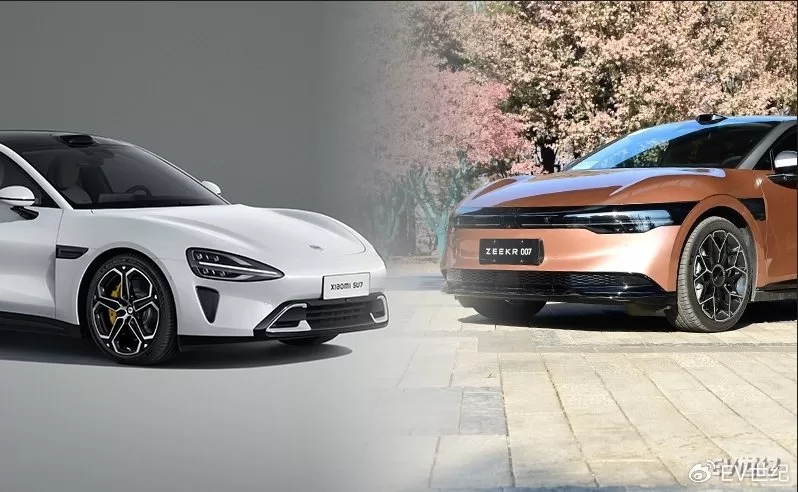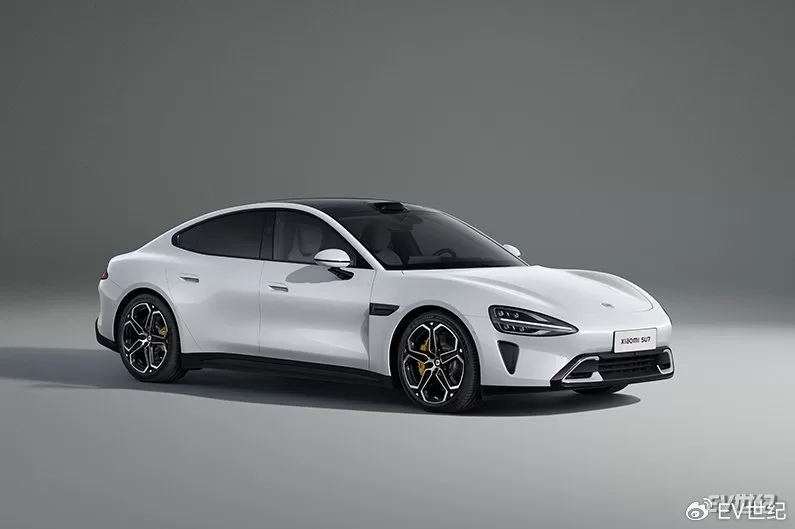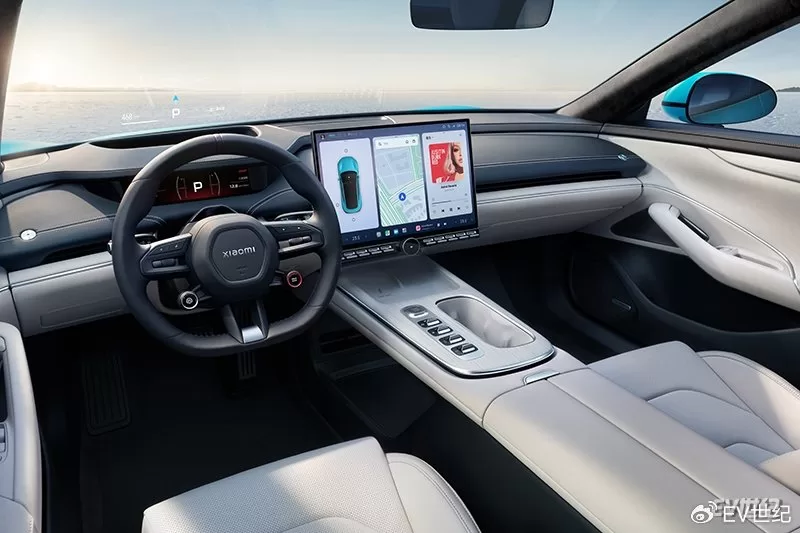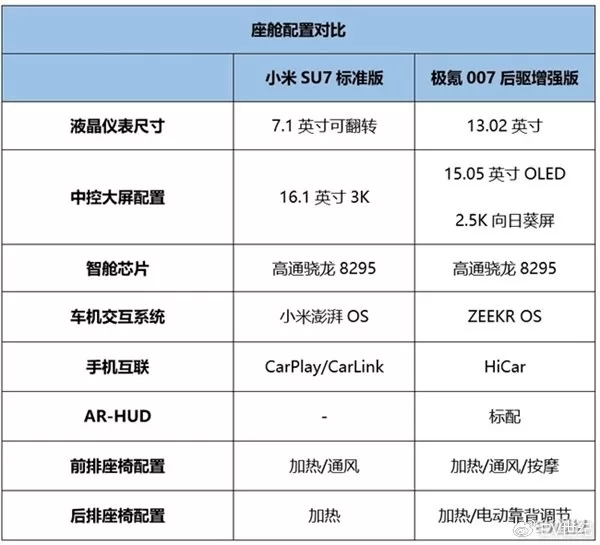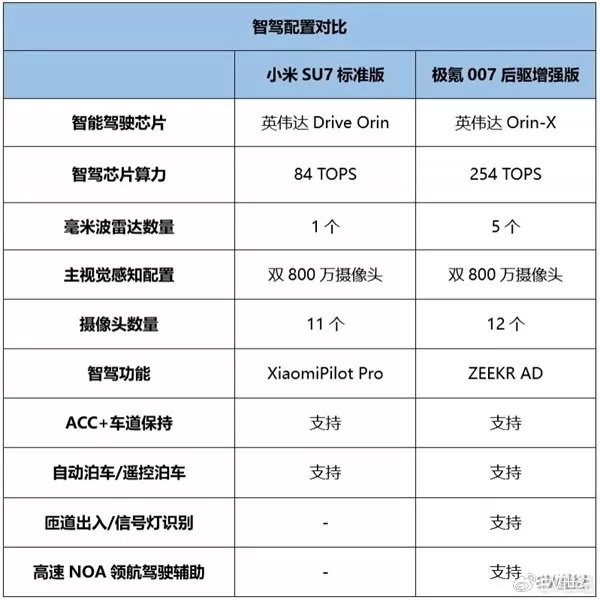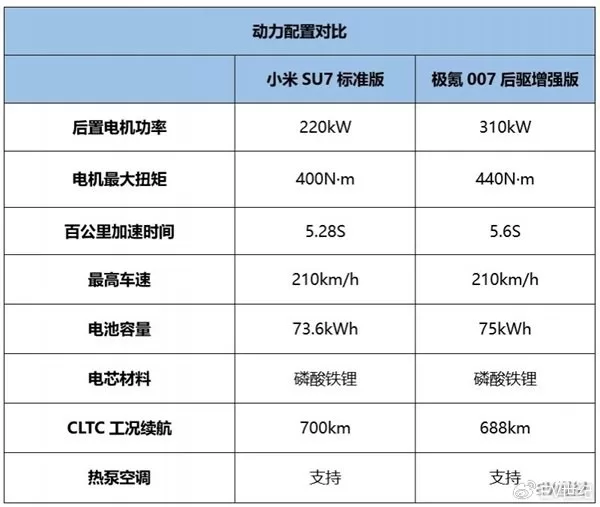After the launch of the Xiaomi SU7, Geely responded quickly by introducing more discount policies for the Geely Galaxy E8. Following that, the Geely Extreme 007, which is positioned and priced similarly to the Xiaomi SU7, released a new rear-wheel drive enhanced version on April 1st, priced at 209,900 yuan (29010$), which is 6,000 yuan (830$) cheaper than the standard version of the Xiaomi SU7 priced at 215,900 yuan (29840$).
So, the question is, as both are pure electric cars, one has a huge amount of traffic, and the other is a strong representative of the new car-making forces. If we ignore factors such as brand and online traffic, and only measure the “three electric”, configuration, intelligence and other products themselves, how should these two cars be chosen? Appearance: “Mi Porsche”, “Porsche Mi” VS Technology Original First of all, it must be admitted that the design of the Xiaomi SU7 is indeed beautiful, the vertical and horizontal body proportions are very appropriate, without the “stupidly high” feeling of previous electric cars. The wide body shape front and back, and the highly recognizable “frog” front face, are very suitable to be the first car for young people.
However, it is difficult to say how many of these successful design elements are unique to Xiaomi’s car. Even the top-of-the-line 21-inch wheels are directly borrowed from Porsche’s RS Spyder model. The title of “Mi Porsche” or “Porsche Xiaomi” is not unfounded. But driving this car on the road, there may be some pressure, and I guess some people share the same thoughts as me.
Compared to others, the appearance of the Jike 007 is more original. It seems that Jike has no tradition of “borrowing” and its design ability is excellent. The Jike 007 has two raised lines on the front hood, enhancing the sense of power without any trace of imitation. The proportions and lines of the body are perfect, and the 90-inch “Stargate” interactive LED screen on the front face is eye-catching. Not choosing to install it may reduce the sense of technology, but it does not affect the overall beauty too much.
In terms of dimensions, the Xiaomi SU7 measures 4997x1963x1455mm with a wheelbase of 3000mm. The Krypton 007 is slightly smaller at 4865x1900x1450mm with a wheelbase of 2928mm. Despite being smaller, the interior space is similar, especially in the rear headroom. The SU7’s rear headroom is not spacious due to its sloping roofline, while the Krypton 007 has an additional fold line in the C-pillar, providing better rear space. Cockpit: Xiaomi SU7 slightly ahead The interior design of the Xiaomi SU7 is in line with current mainstream styles, featuring a 7.1-inch flip LCD instrument panel, a 16.1-inch 3K ultra-clear central screen, and a 56-inch AR-HUD. However, Xiaomi has an advantage in interaction and ecosystem. The new Xiaomi MIUI OS system supports a flexible multitasking framework, allowing desktop applications to be freely dragged, resized, and automatically adapted to various devices. The industry’s first five-seat, five-audio zone interactive function supports stable cooperative wake-up of multiple devices, with almost all operations able to be controlled by voice command through “Xiao Ai”, and core functions support offline use.
The Qualcomm 8295 chip in the top-of-the-line car provides sufficient guarantee for interaction performance and smoothness. However, the focus is clearly on the Xiaomi Penglai OS’s “people-car-home” ecological interconnection. In the video demonstration at the Xiaomi SU7 launch event, you can give commands to the vehicle through Xiao Ai at home, preheating the air conditioning in advance; in the car system, you can control Xiaomi’s smart home products, such as the image of the Xiaomi smart doorbell displayed directly on the car screen. If you happen to be a Xiaomi smartphone user, as long as the car system and phone log in to the same Xiaomi account, the phone can seamlessly connect to the car when entering, and commonly used phone apps can be directly mirrored to the car screen. For Apple users, the Xiaomi SU7 also supports wireless Carplay and iPad.
The interior of the Extreme Krypton 007 is designed with a minimalist tech style, enhanced by the use of high-quality materials. The car’s interface includes a LCD instrument panel, a 15.05-inch large screen, and a 35.5-inch HUD. The resolution of the central screen reaches 2.5K, equipped with a high-quality 8295 chip for fast interaction and application response. The large screen can be electrically adjusted in three directions: towards the driver, towards the center, and towards the passenger, hence called the sunflower screen.
Overall, in terms of interactive experience in the cockpit, Xiaomi SU7 outshines Jike 007 with better smartphone connectivity, powerful ecosystem, and integrated concept of “people, car, home”. Especially for those who already have a lot of Xiaomi smart home products, Xiaomi SU7 feels like another, more expensive and larger member of the Xiaomi ecosystem. Of course, Jike 007’s performance is not bad either, with top-notch hardware and interaction, equipped with AR-HUD head-up display and a three-piece set of seat ventilation, heating, and massage even in entry-level models, which is a bit exaggerated. Smart Driving: Jike 007 Enhanced Edition wins back a point.
In terms of intelligent driving assistance, the Jike 007 enhanced version outperforms the Xiaomi SU7 standard version in both hardware and functionality. Although Lei said all Xiaomi SU7 models use the NVIDIA Orin smart driving solution, the standard version chip comes from the Orin N platform with only 84 TOPS of computing power. Without laser radar sensors, the Jike 007 enhanced version can achieve advanced intelligent driving functions such as high-speed NOA, automatic entry and exit of ramps, and traffic light recognition. If Xiaomi SU7 wants these functions, they need to upgrade to the Pro version priced at 245,900 yuan (33990$). “Three electric”: basically the same In terms of “three electric” and power systems, the Xiaomi SU7 standard version and the Jike 007 enhanced version are similar. Both use rear-mounted single motor drive. Although the Jike 007 has a higher motor power of 90kW, there is no significant difference in torque. In terms of curb weight, the Xiaomi SU7 is 170kg lighter, so ultimately, Xiaomi’s official data shows better acceleration per 100 kilometers.
In terms of endurance, both use lithium iron phosphate batteries with only a 1.4kWh difference in total energy. The CLTC range is only 12km apart. Regardless of the actual range discount, the overall battery energy difference between the two won’t be significant. Xiaomi SU7 and Jike 007 Enhanced Edition are difficult to distinguish in terms of performance and configuration. If you are a loyal Xiaomi fan, buying an SU7 for over 200,000 yuan (27650$) is not unreasonable. Besides the attention, there are some interesting paid accessories like flashlights, walkie-talkies, and fragrances. If you are skeptical of a new brand’s first car, choosing the Jike 007 Enhanced Edition is safer. This car is a mature product with impeccable performance in all aspects.
